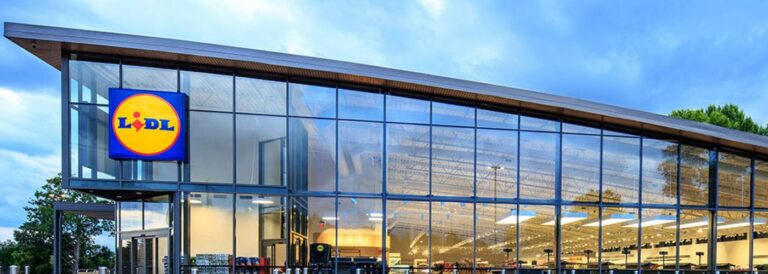The latest grocery market share figures from Kantar Worldpanel, published today for the 12 weeks ending 13 August 2017, show Lidl has increased its market share to a new record high of 5.2% – up 0.7 percentage points year on year – to become the UK’s seventh largest grocer.
Fraser McKevitt, head of retailer and consumer insight at Kantar Worldpanel, said: “Ten million households visited the retailer’s expanding network of stores during the past 12 weeks, with alcohol and fresh produce performing particularly well as the retailer increased sales by 18.9% overall. Lidl is growing sales 40% faster with families than with households without children. Families tend to buy more items each time they shop, so strong growth with this demographic has helped Lidl to increase its average basket size year on year. Not far behind, Aldi grew sales by 17.2%, attracting 1.1 million more shoppers through its doors than this time last year and increasing market share by 0.8 percentage points to stand at 7.0%.”
“Overall supermarket sales grew by 4.0% year on year, although disappointing weather hit summer favourites hard during the past month.
Like-for-like grocery inflation increased slightly to 3.3% after holding steady at 3.2% for the past two months. At the current rate, price increases could add a further £138 to the average household’s annual grocery bill, with the price of butter and fish most affected.
Meanwhile there is good news for the UK’s largest retailers, as the recovery which has so far defined 2017 continues apace. McKevitt said: “All four of Britain’s biggest grocers managed to grow sales for the fifth consecutive period, a run of collective success not seen since 2013. However, this welcome period of sustained growth hasn’t been enough to entirely offset pressure from the discounters: the big four now account for just 69.3% of the UK grocery market – down from 76.3% five years ago – and that looks set to fall further in the coming months.”
Overall sales grew by 3.0% at Tesco, helped by an increase in volume sales, but market share fell to 27.8% – down 0.3 percentage points compared to last year. Morrisons increased sales by 2.6% – the ninth consecutive period of growth for the Bradford-based supermarket – while market share dropped slightly to stand at 10.4%. Morrisons’ online business is performing particularly well: the retailer continues to increase its share of the online grocery market, attracting more shoppers as it expands its delivery service to new parts of the UK. Meanwhile, Sainsbury’s sales rose by 2.0% as the grocer’s market share fell to 15.8% – down 0.3 percentage points year on year.
McKevitt said: “After a difficult couple of years, Asda has managed to continue the run of positive sales performance which began in April this year – up 1.4% during the latest quarter. This follows the retailer’s recent announcement of a return to like-for-like sales growth, suggesting Asda is asserting its recovery across the board. Own label has been important to the grocer’s turnaround, providing a boost from both ends of the price spectrum: the value ‘Farm Stores’ and premium ‘Extra Special’ lines both saw double-digit growth during the past 12 weeks.”
Waitrose’s market share held steady at 5.1% as it managed to increase sales by 2.8% year on year, continuing the unbroken run of growth the grocer has enjoyed since March 2009. Sales of branded goods were up 7% year on year at Waitrose – particularly noteworthy at a time when many retailers are focusing more on their own label lines.
After more than two years in growth, Co-op’s sales declined by 0.4% as its market share fell to 6.3% – down 0.3 percentage points compared to this time last year. This dip is at least partly attributable to the retailer’s sale of nearly 300 of its stores to convenience chain McColl’s. Meanwhile online specialist Ocado increased sales by 12.6%, now holding 1.4% of the overall grocery market.


